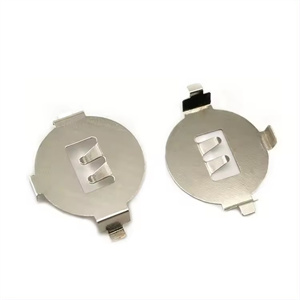Custom Precision Stamping Parts For Electronic Products
Precision stamping plays a crucial role in the application of battery contact. Battery contact, also known as battery connector, charger terminal, battery connector contact, battery spring, etc., is an important component of the battery. It is usually made of materials such as copper, iron, stainless steel, etc., and undergoes electroplating treatment such as CT, silver, nickel, etc. to enhance its conductivity and corrosion resistance.
Precision stamping parts technology is widely used in the manufacturing process of battery contact. precision stamping parts uses high-precision molds to continuously deform metal sheets to form the desired shape of battery contact. This technology can ensure that battery contact has excellent shape accuracy, dimensional accuracy, and surface quality, thereby meeting the high requirements of battery connection.
The main function of battery contact is to ensure a stable connection between the battery and the device, in order to achieve smooth current transmission. Due to the pressure and vibration that battery contact needs to withstand, there are very high requirements for its quality and performance. Precision stamping technology can ensure that battery contact has sufficient elasticity and conductivity, thereby ensuring the reliability and stability of battery connections.
In addition, precision stamping parts technology can also achieve efficient mass production of battery contact, improve production efficiency and reduce costs. This is of great significance for battery manufacturers as it can help them meet market demand and improve competitiveness.
In summary, precision stamping parts plays a crucial role in the application of battery contact, ensuring the reliability, stability, and efficiency of battery connections.
The application of precision stamping in electronic products is extensive and in-depth, mainly reflected in the following aspects:
Firstly, precision stamping parts technology provides an efficient and accurate way of producing parts in the field of electronic manufacturing. Electronic components, such as connecting devices, connectors, brushes, electrical terminals, elastic parts, etc., require very high accuracy and precision of the parts. Precision stamping parts technology can ensure that the dimensional and shape accuracy of these parts reaches an extremely high level, thereby improving the performance and reliability of electronic products.
Secondly, in communication equipment, precision hardware stamping parts provide reliable electrical connections, ensuring the optimal contact resistance and electrical conductivity of connectors, thereby ensuring the stability and reliability of signal transmission. In addition, precision stamped parts can also optimize signal transmission by precisely controlling the shape and structure of the stamped parts, reducing losses and interference during signal transmission, and improving signal clarity and stability.
Furthermore, precision stamped parts also play a role in providing stable mechanical support in electronic products. Electronic products usually need to withstand various environmental and mechanical stresses, such as vibration, impact, and temperature changes. Precision stamping parts can provide stable mechanical support, ensuring the stable operation of electronic products under harsh conditions, thereby extending the service life of products.
In addition, with the increasing trend of miniaturization and lightweighting of electronic products, precision stamping parts technology has also played an important role in this regard. By optimizing stamping processes and mold design, smaller and lighter parts can be manufactured to meet the space and weight requirements of electronic products.
The application of precision stamping parts in electronic products not only improves product performance and reliability, but also promotes the miniaturization and lightweight process of electronic products.
